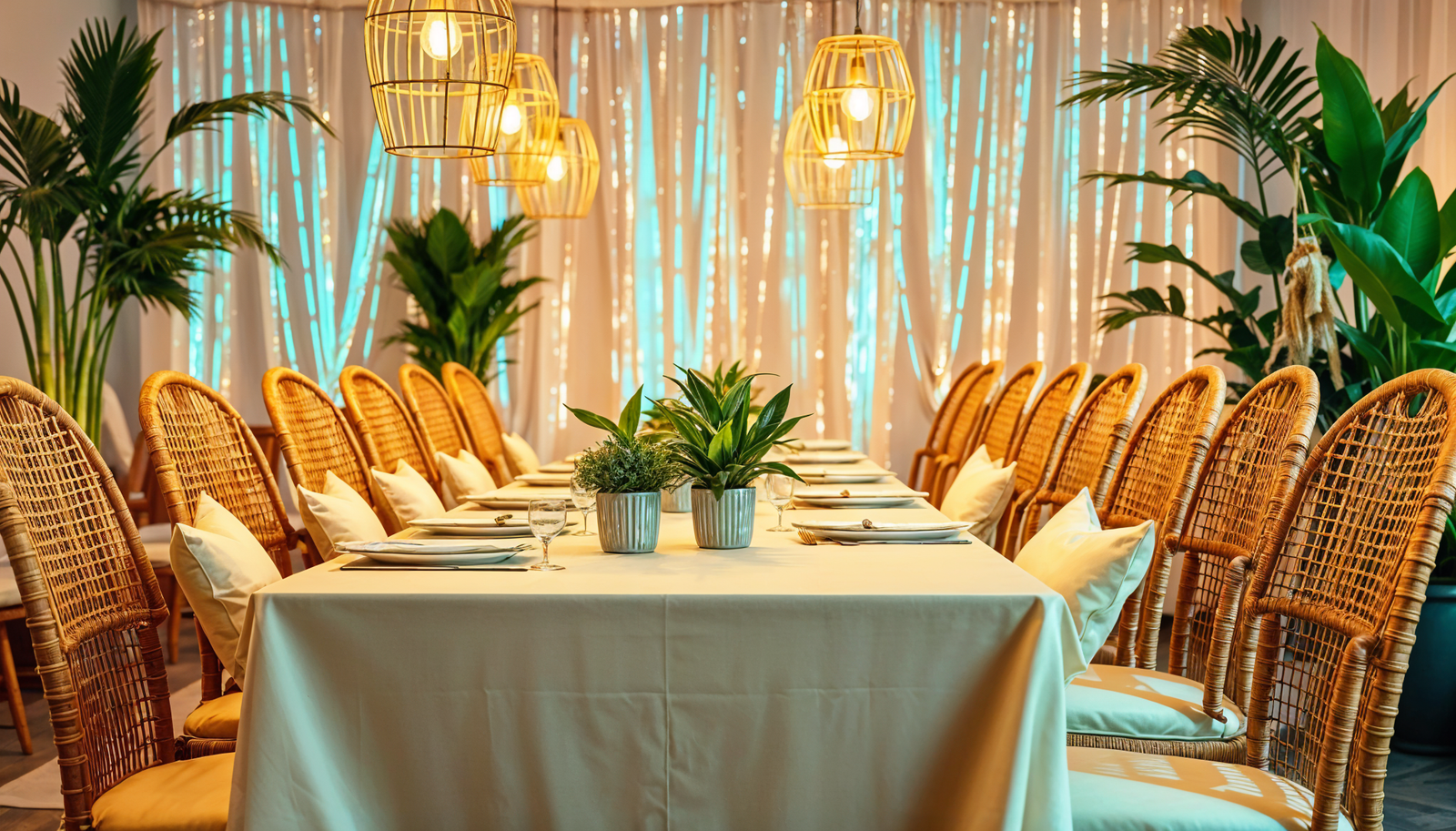🤍 Unmatched Quality, Authentic Craftsmanship
🤍 Unmatched Quality, Authentic Craftsmanship
🤍 Unmatched Quality, Authentic Craftsmanship
Welcome to our latest article on interior design! Today, we're diving into the world of plant-centric interior design and exploring how incorporating plants can transform your living space into a nature-infused oasis. Whether you're a fan of botanical beauty or looking to embrace a green decor style, plants can add a refreshing touch to any room. So, let's dig in and discover the wonders of plant-centered interior styling together! Biophilic design is an innovative concept in interior design that seeks to establish a profound connection between the built environment and the natural world. This approach emphasizes the integration of natural elements, particularly plants, to enhance the well-being and overall experience of occupants. By incorporating biophilic design principles into interior spaces, architects and designers can create sustainable, visually appealing environments that foster a deep connection with nature. One of the key elements of biophilic design is the incorporation of indoor plants. These living organisms not only add beauty and aesthetic appeal but also provide a multitude of benefits that contribute to a harmonious and healthy living environment. By bringing the outdoors inside, indoor plants create a sense of tranquility and serenity, promoting relaxation and reducing stress levels. Studies have shown that being in proximity to nature has a positive impact on our overall well-being. The presence of plants in interior spaces helps to improve air quality by naturally filtering and purifying the air, removing harmful toxins and releasing oxygen. Moreover, plants have a calming effect and can help to reduce anxiety and improve cognitive function. Integrating indoor plants in interior design has become increasingly popular due to the numerous advantages associated with biophilic design. From improving air quality and reducing noise levels to enhancing creativity and boosting productivity, the benefits of incorporating plants in interior spaces are abundant. As more people live in urban areas, the need to bring nature into city homes becomes increasingly important. In this section, we will explore how to incorporate plants into urban interior design, creating a green oasis in the concrete jungle. From small apartments to high-rise buildings, discover ways to embrace biophilia and reconnect with nature in urban living spaces. Urban environments can often feel disconnected from nature, but incorporating plants into interior design can bridge that gap and create a sense of tranquility and serenity. Whether you have a spacious loft or a compact studio, there are various ways to infuse greenery into your living space. One approach to incorporating plants in city homes is to utilize vertical space efficiently. Vertical gardens or living walls can be installed, allowing you to maximize the use of limited floor space while creating a lush, green focal point. These vertical gardens not only bring nature indoors but also improve air quality and acoustics in your home. For those with smaller living spaces, potted plants and hanging planters are excellent options. They can be placed on shelves, windowsills, or mounted on walls to add a touch of greenery without taking up valuable floor space. Hanging plants can also create visual interest and add a sense of depth to your interior design. When choosing plants for urban interior design, consider the lighting conditions in your space. If you have ample natural light, consider plants that thrive in bright, indirect light, such as succulents, spider plants, or pothos. Alternatively, if your space lacks natural light, opt for low-light plants like snake plants or ZZ plants that can thrive in artificial lighting. Incorporating plants in city homes not only brings nature into your living space but also offers numerous benefits. Plants have been shown to improve air quality, reduce stress levels, and boost overall well-being. By embracing biophilic design principles, you can create a harmonious and inviting environment that promotes a sense of calm and connection with nature. When incorporating plants into your city home, there are a few key considerations to keep in mind: By incorporating plants in city homes, you can transform your urban living space into a vibrant, green sanctuary that fosters a connection with nature. Embracing biophilia in interior design brings numerous benefits that go beyond aesthetics, enhancing your well-being and creating a soothing retreat in the midst of the concrete jungle. Indoor plants play a crucial role in enhancing indoor air quality. They act as natural air purifiers, removing pollutants and toxins from the air and releasing oxygen. Incorporating plants into interior design not only adds aesthetic appeal but also brings numerous health benefits. To improve air quality in your home, consider incorporating the following plants: By incorporating these natural air purifiers into your interior design, you can create a healthier and more refreshing living space. Natural light is essential for creating a bright and inviting interior space. To maximize the benefits of natural light and enhance your green decor, strategic placement of windows and mirrors is key. By harnessing the power of sunlight, you can create a harmonious balance between light and greenery in your home. One effective strategy is to strategically position windows to optimize natural light penetration. Consider the orientation of your space and the intensity of sunlight throughout the day. Placing windows on the south-facing side allows for ample sunlight exposure, while windows on the north-facing side provide more even, diffused light. In addition to windows, mirrors can be used to reflect and amplify natural light. Placing mirrors opposite windows can bounce light around the room, making it feel brighter and more spacious. Experiment with different mirror sizes and shapes to find the optimal placement for maximum light reflection. When incorporating plants into your interiors, it's essential to choose varieties that thrive in natural light. Some plants require direct sunlight, while others prefer indirect or filtered light. Research the lighting requirements of different plant species and select those that align with the natural light conditions in your space. By considering the lighting requirements of your chosen plants and strategically placing windows and mirrors, you can optimize natural light in your interiors and create a vibrant, green oasis. Let the beauty of natural light and green decor transform your home into a serene and inviting space. Sustainable design is at the forefront of interior design as we become increasingly aware of our impact on the environment. Embracing sustainable materials not only helps to reduce our carbon footprint but also creates a nature-infused look that is both stylish and eco-friendly. When it comes to incorporating sustainable materials in interior design, woods, bamboo, and cork are excellent choices. These materials are renewable, biodegradable, and have a low environmental impact. Woods, bamboo, and cork can add a touch of natural beauty to any space. Whether it's hardwood floors, bamboo furniture, or cork wall coverings, these materials bring warmth, texture, and a sense of tranquility to your interior design. Woods such as oak, teak, and walnut are not only visually appealing but also durable and long-lasting. Bamboo, on the other hand, is a fast-growing grass that can be used for flooring, furniture, and even decorative accents. Cork, known for its natural insulating properties, is an excellent choice for flooring, wall coverings, and furniture. By incorporating these sustainable materials into your decor, you can create a space that is both aesthetically pleasing and environmentally conscious. In addition to sustainable materials, choosing eco-friendly furnishings is another way to create a nature-infused look in your interior design. Opt for furniture made from recycled or reclaimed materials, such as reclaimed wood or recycled plastic. When it comes to upholstery and textiles, look for eco-friendly options made from natural fibers, such as organic cotton, linen, or hemp. Avoid synthetic materials that can release harmful chemicals into the environment. Accessorize your space with nature-inspired decor, such as plant-based dyes, organic rugs, and handmade pottery. These small details can make a big impact and contribute to an overall eco-friendly and nature-infused aesthetic. By embracing woods, bamboo, and cork in your decor and choosing eco-friendly furnishings, you can create a nature-infused look that brings the beauty of the outdoors into your home while being mindful of the environment. When it comes to interior styling, not all plants are created equal. Choosing the right types of plants for your space is essential to ensure they thrive and enhance the overall aesthetic. Consider factors such as lighting conditions, humidity levels, and maintenance requirements when selecting plants for your interior design. There is a wide variety of indoor plants to choose from, each offering unique beauty and benefits. From low-maintenance options perfect for busy individuals to striking statement plants that make a bold statement, the possibilities for botanical beauty are endless. To help you make the right choice, let's explore some popular types of plants that are well-suited for interior styling: These are just a few examples of the types of plants that can bring botanical beauty to your interior design. Remember to consider your space's specific requirements and your personal preferences when choosing plants. Experiment with different varieties to create a unique and inviting atmosphere in your home. As we explore the use of plants in interior design, it's important to understand the specific design styles that incorporate and highlight greenery. This section will delve into various interior design styles, discussing how plants are used to enhance each aesthetic. From bohemian to Scandinavian and tropical design, different styles embrace the beauty and vitality of plants, creating plant-centric design aesthetics. Whether it's through the bohemian, Scandinavian, or tropical design, incorporating plants in interior design brings a sense of natural beauty and serenity to any space. The use of plants as design elements enhances the aesthetics of a room and creates a plant-centric design that connects us with nature. Plants have the remarkable ability to serve as powerful focal points in interior design, completely transforming spaces and creating a unique visual impact. Incorporating plants as central elements in interior styling can bring a refreshing and vibrant atmosphere to any room. From vertical gardens that add a touch of green to bare walls, to living walls that create a statement piece, and large plants that demand attention, there are several creative ways to make plants the center of attention in your interior design. One fantastic way to incorporate plant-centered interior styling is through the use of vertical gardens. These gardens are not only visually appealing but also make efficient use of space. By attaching plants to a trellis, grid, or even a wall-mounted planter, you can create a beautiful display that adds texture and life to your walls. Whether you choose to showcase a selection of small plants or opt for larger, cascading foliage, vertical gardens are sure to make a stunning focal point in your space. In addition to vertical gardens, another way to incorporate plant-centered styling is through the use of living walls. Living walls, also known as green walls or vertical gardens, are self-sufficient plant systems that are vertically attached to a wall. They can range from simple installations with a few plants to elaborate structures with intricate designs and hundreds of plants. A living wall not only adds beauty to a space but also has numerous benefits such as improving air quality, reducing noise levels, and creating a sense of tranquility. Another approach to plant-centered interior styling is to incorporate large statement plants. These plants immediately draw the eye and become the focal point of a room. From towering fiddle leaf fig trees to voluminous monstera deliciosa plants, large statement plants can add a dramatic touch and create a bold statement in your interior design. Placement is key when using large plants as focal points, as they often require sufficient space and complementary decor to make the desired impact. Now that you have read the above article, maybe you still have a couple of questions on this topic, so we will answer these questions below. Biophilic design is a concept that focuses on creating a connection between the built environment and the natural world. It emphasizes the use of natural elements, such as plants, in interior design to improve well-being and create a sense of harmony. Not all plants are suitable for interior styling. When selecting plants for your space, consider factors such as lighting conditions, humidity levels, and maintenance requirements. There are various types of plants suited for interior styling, from low-maintenance options to statement-making plants. Different interior design styles incorporate and highlight greenery in their aesthetic. Whether it's bohemian, Scandinavian, tropical, or any other design style, plants can enhance the beauty and vitality of the space. Incorporating plants in interior design can have a transformative effect on your home, providing a multitude of benefits that go beyond just aesthetics. Throughout this article, we have explored the various ways in which plants can enhance your living spaces and create a serene and nature-infused ambiance. One of the key advantages of integrating plants into your home decor is the improvement of indoor air quality. Plants act as natural air purifiers, removing pollutants and toxins from the air and releasing fresh oxygen. By choosing the right plants known for their air-purifying properties, you can create a healthier and cleaner environment for you and your family. Moreover, embracing nature in interior design has been proven to have a positive impact on our overall well-being. The presence of plants in our living spaces can reduce stress, boost mood, and improve concentration. By creating soothing and natural environments with the strategic placement of windows, choice of plant varieties, and incorporation of sustainable materials, we can create a home that promotes relaxation and tranquility. Embracing the beauty and vitality of plants is not limited to a specific interior design style. Whether you prefer a bohemian, Scandinavian, or tropical aesthetic, there are countless ways to incorporate plants in a way that enhances each style. From becoming central focal points to providing green accents, plants have the power to transform any space into a captivating oasis. In conclusion, by embracing nature and incorporating plants in your home decor, you can reap the benefits of improved air quality, enhanced well-being, and a visually appealing space. Embrace the power of greenery and let your home become a sanctuary that connects you with the beauty of the natural world.
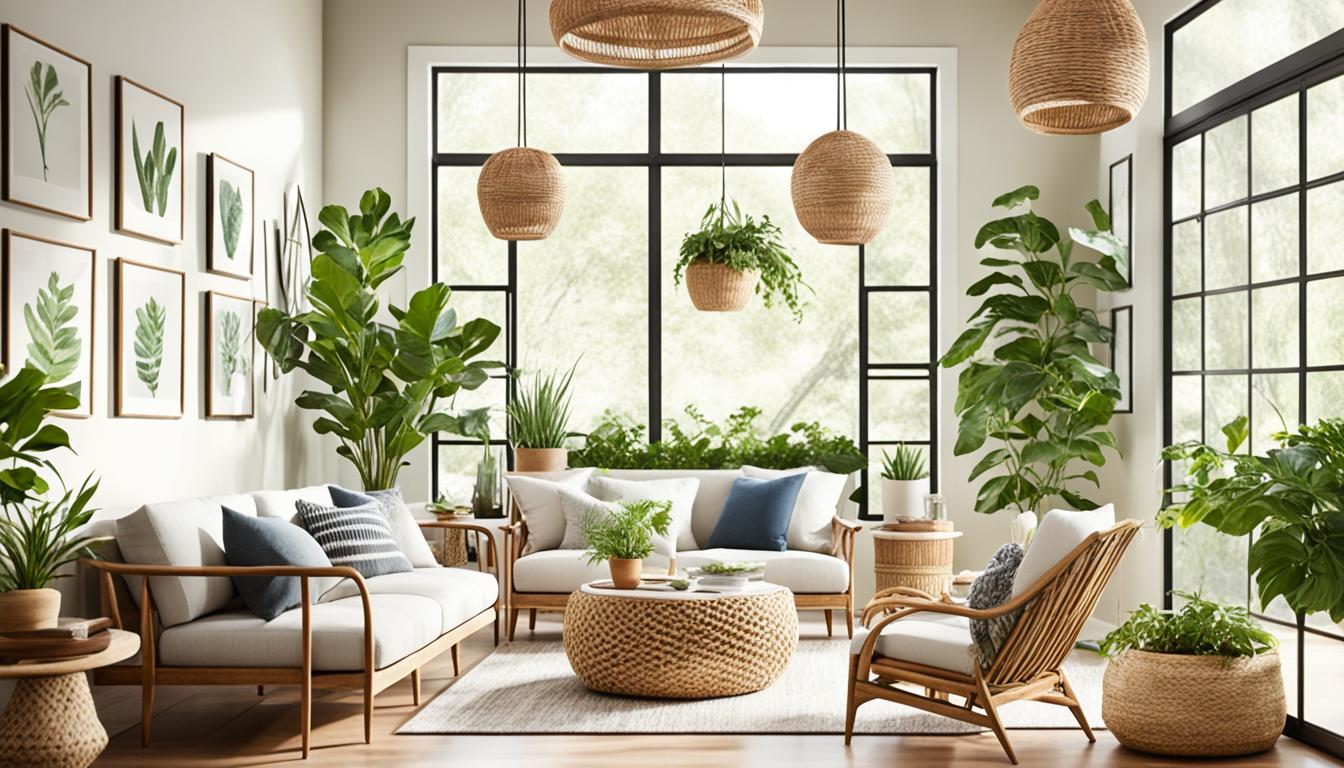
Key Takeaways:
Understanding Biophilic Design
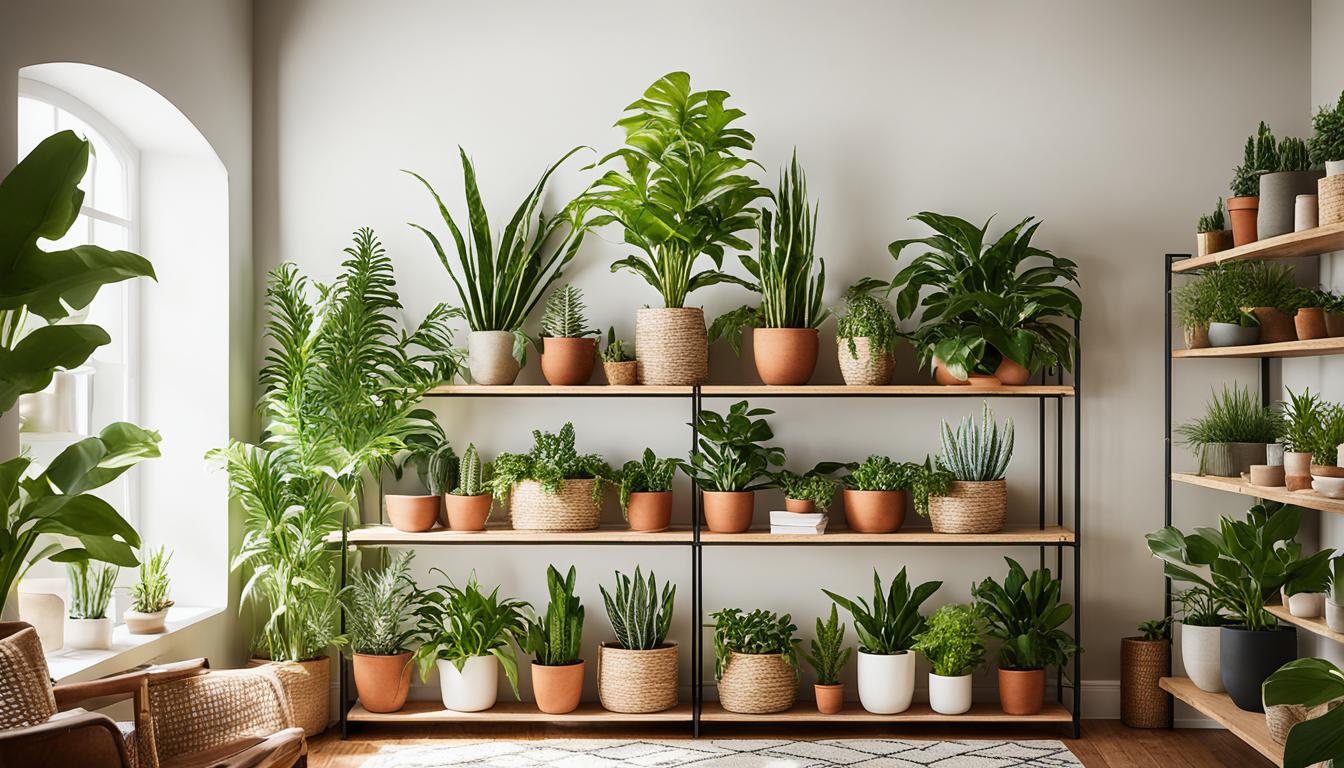
Fusing Natural Elements with Urban Living
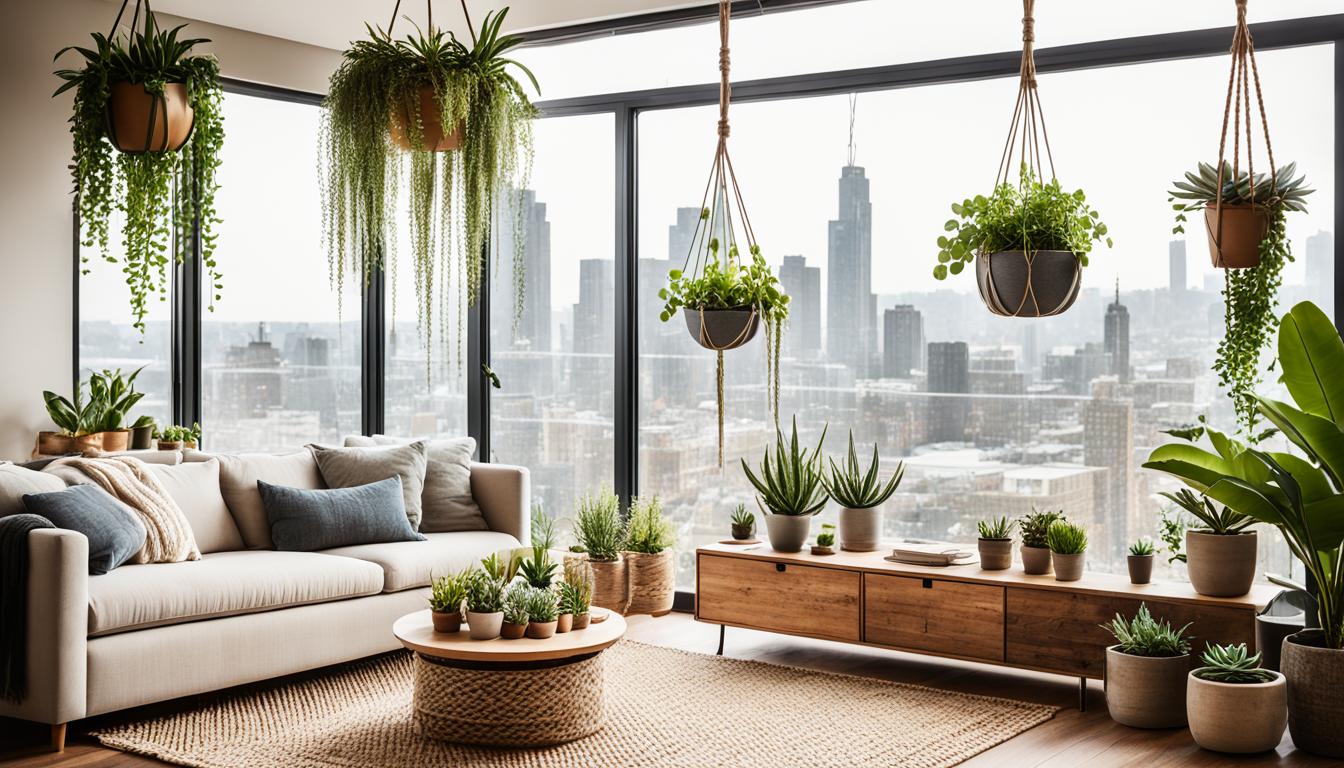
Incorporating Plants in City Homes
Benefits of Incorporating Plants in City Homes
Ways to Incorporate Plants in Urban Interior Design
Improved indoor air quality
Vertical gardens or living walls
Reduced stress levels
Potted plants and hanging planters
Enhanced overall well-being
Choosing plants based on lighting conditions
Added visual interest and depth
Strategic placement in different areas of the home
The Role of Plants in Enhancing Indoor Air Quality
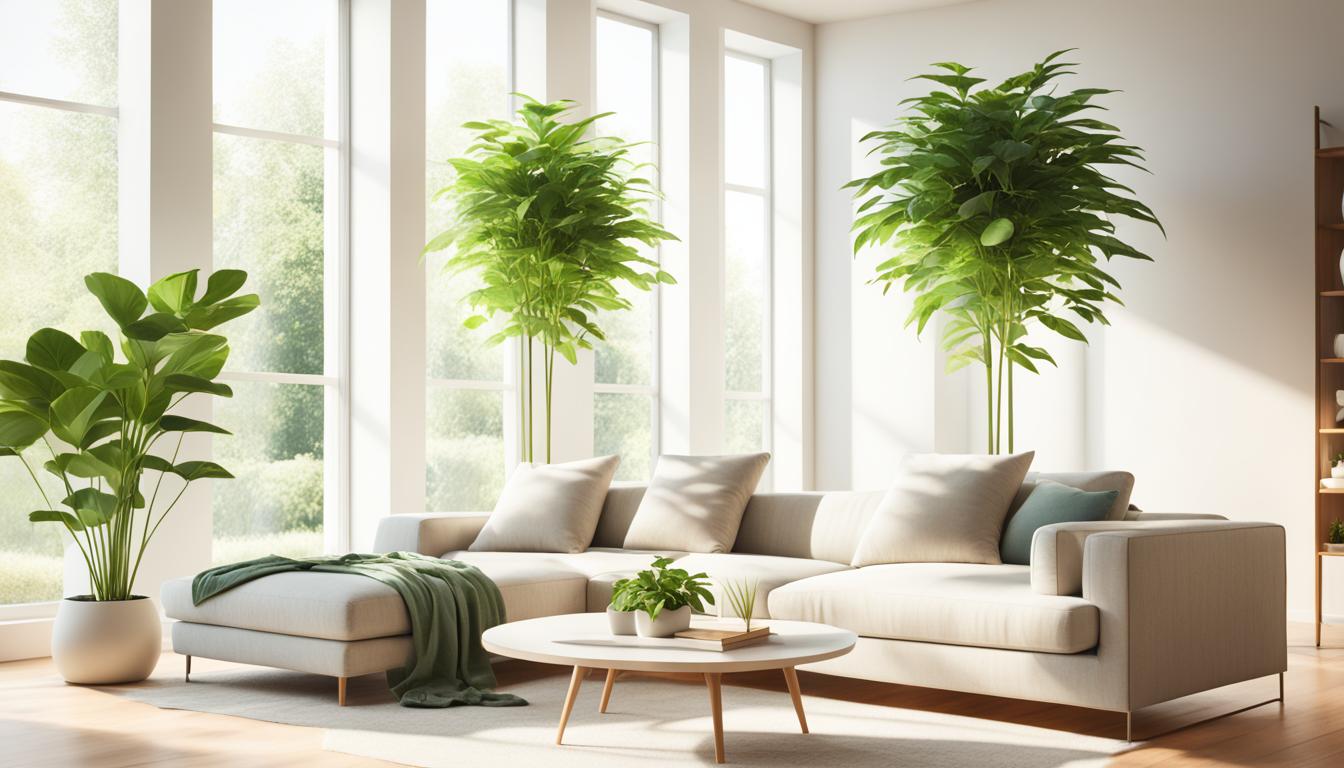
Plant
Air-Purifying Property
Snake Plant
(Sansevieria trifasciata)Absorbs formaldehyde
Peace Lily
(Spathiphyllum spp.)Filters benzene
Golden Pothos
(Epipremnum aureum)Removes formaldehyde, benzene, xylene, and toluene
Chinese Evergreen
(Aglaonema spp.)Filters airborne toxins and pollutants
Spider Plant
(Chlorophytum comosum)Removes formaldehyde and xylene
Areca Palm
(Dypsis lutescens)Filters indoor air toxins and adds moisture
Aloe Vera
(Aloe vera)Removes formaldehyde and benzene
How to Integrate Natural Light with Green Decor

Plant Variety
Lighting Requirements
Snake Plant (Sansevieria)
Low to moderate light
Pothos (Epipremnum aureum)
Indirect to low light
Spider Plant (Chlorophytum comosum)
Indirect to moderate light
Rubber Plant (Ficus elastica)
Moderate to bright indirect light
Peace Lily (Spathiphyllum)
Indirect to low light
Designing with Sustainable Materials
Embracing Woods, Bamboo, and Cork in Decor
Eco-Friendly Furnishings for a Nature-Infused Look
Sustainable Materials
Benefits
Woods
- Renewable
- Durable
- Adds warmth and texture
Bamboo
- Fast-growing
- Versatile
- Eco-friendly alternative to hardwood
Cork
- Natural insulation
- Renewable
- Adds unique texture
Recycled/Reclaimed Materials
- Reduces waste
- Unique character
- Adds sustainability to decor
Organic Fibers
- Environmentally friendly
- Biodegradable
- Non-toxicAdding Botanical Beauty: Types of Plants Suited for Interior Styling
What Interior Design Style Uses Plants
Transforming Spaces with Plant-Centered Interior Styling
Vertical Gardens
Living Walls
Large Statement Plants
Create a beautiful display on walls
Add life and texture to your space
Draw the eye and create a bold statement
Efficient use of space
Improves air quality and reduces noise levels
Requires sufficient space and complementary decor
Perfect for showcasing small or cascading plants
Creates a sense of tranquility
Makes an immediate visual impact
Frequently Asked Questions
What is biophilic design?
What types of plants are suitable for interior styling?
Which interior design styles incorporate plants?
Conclusion
